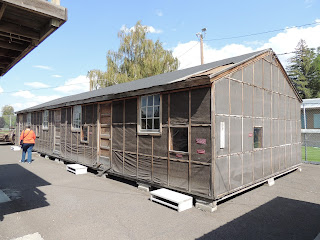August 13, 2013
Headed out a little
earlier than usual this morning, had about an hours drive to reach our
destination of Lassen Volcanic National Park. Lassen Peak formed 27,000 years
ago, is one of the world’s largest plug dome volcanoes, rising to an elevation
of 10,457’. A plug dome volcano generally has very thick lava, it moves slowly,
giving plenty of warning to get out of its way.
From Redding, we headed
east on Highway 44, bringing us into the park on the north side. The Visitor’s
Center is at the south entrance, and key stops, view points and historical
events are noted with numbered sign posts along the road, starting at the
Visitor’s Center. If you have a choice, I would recommend that you stop at the
Visitor’s Center and pick up a little book called “Lassen Volcanic National
Park Auto Tours, Trips & Trails”. This book will follow the markers on the
road and tell you what the significant event was at each marker. We did the road backwards, and then picked up
the book, we enjoy being different…anyway, the park is beautiful and at every
turn there is a different view, a different landscape. There are 16 of these
road markers along the 29 mile long road through the park; I’m not going to try
to hit all of them.
A few are worth
mentioning, I will try to keep comments brief (LOL). Also, I will note them by
using the correct number of the road marker.
Stop #2 is called the
Sulphur Works. You will notice a sharp sulfur smell, the ground is barren and
there are clouds of steam rising from the earth, there are also mudpots boiling
and steaming like pots of thick pudding.
When I was here with my family as a kid, I remember accessing these via a boardwalk, but now they are roped off and you can only view them from the sidewalk.
Stop #5 is Emerald Lake is
a shallow glacial lake.
Because it is so shallow sunlight warms the water and
the bottom of the lake enough for green algae to grow, creating its emerald
green color.
Stop #7 is Lake Helen,
larger than Emerald Lake, this lake has the look of a true alpine lake and the
reflection of the surrounding trees is beautiful.
Lake Helen is about 110’ deep
and stays frozen 7-8 months each year and it is believed to be somewhere
between 25,000 and 120,000 years old.
Stop #9 is the Kings Creek
Area.
This is a beautiful green meadow with the Kings Creek winding its way
through the meadow.
Stop #11 is called the
Devastated Area and well named it is! The 1915 eruptions transformed this place
from a mature forest and colorful, flower filled meadow to a landscape of
complete “devastation.” Parts of this area were filled with over 20’ of mud and
volcanic debris as a result of the various eruptions.
Stop #14 is called Chaos
Jumbles
and is another area of devastation, this one caused about 350 years ago
by three large avalanches, bringing down enormous masses of rocks, pumice stone
and other volcanic debris. In the years since the avalanche a forest of dwarf mixed
conifers has grown up on top of the jumbled rock debris. Because there is
limited soil with the nutrients needed for full growth, the trees look like
young growth, but in fact may be more than 290 years old.
Lassen last exploded on
May 22, 1915 with a powerful eruption that blasted rock and pumice high into
the sky. A huge column of ash and gas rose more than 30,000’ and was visible as
far away as 150 miles to the west. Smaller eruptions continued after the May 22nd
event, in 1917 steam explosions blasted out of the smaller of the two craters
on the summit. Although Lassen has been quiet for many years, the steam vents,
mudpots and hot springs still found in the park are an indication that a still
active reservoir of magma hides beneath the mountain. No one can say when, but it’s
a pretty sure bet that someday the Lassen area will experience volcanic
eruptions again.
We had a great day
exploring the park, it was about 10 degrees cooler up there, the park road
reaches a summit height of 8,512’. As we came out of the south entrance to the
park, we followed Highway 36 back to I-5, then north back to Redding. Highway
36 was a landscape of jumbled volcanic rock. About the only thing this land can
be used for is cattle grazing, no way could it be cultivated.






















